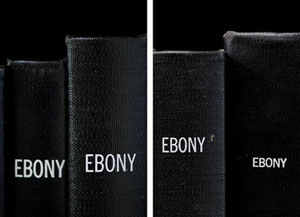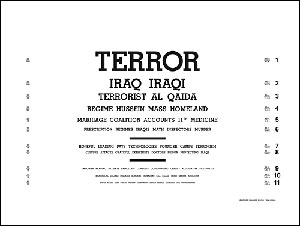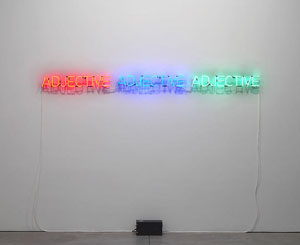Text Messaging
John Haberin New York City
Mickey Smith, R. Luke DuBois, and David Diao
"If you want to send a message, call Western Union." Sam Goldwyn supposedly said that, and Bob Dylan once adapted it to disavow protest music. But hey, they only made movies and music, and who still sends a telegram anyway? Artists think they know better.
Several recent shows confront viewers with mere words. In each case, though, the medium brings with it images, and in each case a different medium disguises the source and meaning of the words. In each case, too, words link the art to public documents and personal histories. For Mickey Smith, a photograph wrenches harsh language out of scholarly records. For R. Luke DuBois, light boxes and eye charts hold out presidential visions. And for David Diao, words mingle with dozens of other signs, as an exploration of painting and the artist's past. 
The claim of art as a language comes up often with Postmodernism. So does the claim that art is ultimately beyond words. Related articles have teased out the relationship between art and signs, as well as why art takes words and not just looking. This article sticks to watching art and signs in the making. After nearly forty years, art about art has stumbled into history.
More than words
Dozens since Cubism have incorporated text in paint or in newsprint. Joseph Kosuth has stenciled it onto glass and walls, photographed it, and trapped it in repetitive neon. Jenny Holzer has projected it onto famous buildings, set it in stone, and watched it crawl by on LED. Lawrence Weiner has covered (and blasted) into museum walls.
As it happens, all three examples from Kosuth have turned up again in Chelsea. By its uniform font, repeated color, and arbitrary line breaks, their neon lights strip letters of their reference, while leaving a commentary on art. The gathering of his early work also includes a deconstruction of Marcel Duchamp's In Advance of a Broken Arm into a snow shovel, a photograph of Duchamp's found object, and a typed definition—but not yet, presumably, a broken arm. As perhaps the ultimate detachment of signifier from signified, in his Information Room art piles on newspapers and books from just one year, 1970. Ironically, it has acquired a cultural context that Kosuth never have intended. It has become a nostalgic record of political and intellectual currency almost forty years ago.
That says something about the possibility for text in art today. It also gets one barely into the 1970s—when "art as language," well, meant something. I gave up counting the artists in "Looking at Words," a group show a few years back, at eighty-five. And this just took me, appropriately enough, to General Idea. So if Mickey Smith photographs words on fabric, what more can she say?
How about BLOOD, again and again in block letters, covering a long wall? Deep red dominates the grid of forty prints, disrupted only by that rarity on the Lower East Side, blue blood. Some of the white letters on colored materials appear broken or faded, as if some actual human body and not just its signifier had sustained injury. Or how about EBONY, naturally in black and white? In accord with the nature of language, others can create their own messages. One client, Smith says, has paired frames of BLOOD and MONEY, for a rebus closer to urban graffiti than to Kosuth's scholarly detachment.
Humor alone shows respect for words (and for the 2010 Volta art fair, she even found a journal called Volta), but not solely for language. Ed Winkleman, the dealer and blogger, has pleaded for conceptual art with visual impact. Smith's close-ups and long exposures bring out the fabric's weave and texture against a deep black background. Her actual subject links her further to text as physical object. She has gone from library to library, photographing bound journals before they vanish entirely, sometimes with no digital remainder. These battered volumes of Who's Who in America date from before 1920, and who knew that Who's Who in Canada once ran to more than five pages?
Smith leaves each viewer to sort out the balance of text and image, surface and grid, irony and physical loss. One has only oneself to trust for the history within these volumes—and only oneself to blame for laughing at a pairing of American Girl and How to Play with Boys. She evokes a book's feel in one's hand, but her procedure is a kind of appropriation, too. She only seems to have worked with stencil on fabric herself. Her camera angle disguises her source, in that one never sees the top of pages. Still, a work insists, one can LOOK.
That vision thing
But can anyone really look at art at an arts fair? As a test, Pulse greeted its 2009 visitors with forty-three eye charts. However, R. Luke DuBois drew their text not from the usual bewildering letters, but from each president's State of the Union addresses. Talk about "that vision thing."
Perhaps you hurried past them, anxious at the prospect of so many exhibitors and so much art. The charts, one per president, lined the athletic field outside on the Houston Street pier. Little else the weekend of the Armory Show comes free, and that itself makes a political statement. The work's concept has a similar populism. So much public idealism, so much political maneuvering, and so many tests of leadership—they all stand open to public scrutiny, each in its own light box. They also reflect the push in this year's fairs toward more displays by a single artist.
 If you did rush past, you missed an unsettling of obvious message: so many platitudes, so little time. On this view, the work has much in common with early work by Holzer, her Truisms on crawl screens in public spaces. There, too, the ideal of transparency blends into paranoia. Stopping to look again on the way out, though, one might discover something else again. Of course, as DuBois's title has it, Hindsight Is Always 20/20.
If you did rush past, you missed an unsettling of obvious message: so many platitudes, so little time. On this view, the work has much in common with early work by Holzer, her Truisms on crawl screens in public spaces. There, too, the ideal of transparency blends into paranoia. Stopping to look again on the way out, though, one might discover something else again. Of course, as DuBois's title has it, Hindsight Is Always 20/20.
The work thrives on that second look, and it invites scrutiny of America's history. DuBois ranks words for each president according to their frequency. Since Bush staked his policy and popularity on repeating the word terror again and again, it lands at the top of his chart in the largest letters. A computer takes care that each line of the chart comes to the right number of letters. Realizing all this leaves a nice sensation: suddenly the work adds up, just as in a time line of documents on Iraq at the center of another work, on display at Pace University.
DuBois, also a composer on the faculty at Columbia, aims for the state of the art. (How natural for the art fairs.) In his fall gallery show, he electronically extended "The Star Spangled Banner" to four hours. That work also hints at a good artist's weakness. It sure sounds like political art, but what exactly is its politics, and how much of it will one stop to hear? Something of the same problem dogs this display—when it comes down to it, not so different from the ordinary word clouds easily found online.
That second look starts so wonderfully, but the text also leaves a third impression, one less true to the past. Sure enough, Clinton had the economy (stupid), Reagan deficits (aka big government), Buchanan slavery (unresolved in his dismal term), and Lincoln emancipation. With history this clear, no wonder the work made a huge hit a few months earlier, at the Democratic national convention in Denver. Still, with three impressions, the work packs at least two more than most art, and it shows that a popular American art does not have to choose between Andrew Wyeth and Keith Haring. When George Washington repeated gentlemen, did he stand for a lost sense of community or just gentility and sexism? In the end, DuBois trusts to silence.
The tennis court oath
From Kosuth or Mira Schendel to the present, art as text seems paradoxically to depend on that silence. Words rush by, but they speak for themselves. Yet David Diao, by all signs, is in a confessional mood. His show has I twice in its title alone: I lived there until I was 6. . . It hardly seems like him.
Hardly a decade ago, painting was still in its lean years, and a show of "Abstraction Since 1970" at Snug Harbor, out on Staten Island, all but embodied its isolation. I noticed Diao's contribution most for its spareness and darkness. Now his paintings do not function alone, and they do not function apart from what they describe. He gives over an entire gallery to a series on the Da Hen Li House, built by his grandfather. Has he given up on abstraction for good, or is he finally coming home?
The very first painting tells of return and recovery, starting with the title and continuing. "When I returned to Chengdu 30 years later, it had just been demolished. There are no photographs. The only certain scale to rub up against my memories was the tennis court. I have since uncovered ciphers of its having been." Yes, you can go home again, but the home may no longer be there.
Even in China, in a regime dependent on enforced silences, one can find the evidence, or maybe not. One can read the text as about loss and nothing more—or about art as in search of its signs. It begins with a child's exile in 1949, the year of the revolution, when the Sichuan Daily seized his home for its headquarters. Its careful wording speaks of demolition, no photographs, uncertainties, and ciphers. Even the ciphers, like the certain scale of the tennis court, may exist only in memory.
Another painting marks the court's precise dimensions, right down to baselines and alleys. Then again, Diao could have taken those from the rules of tennis. He could be using the rules of the game to fill in the gaps in painting or in memory. He letters as neatly as another blank diary, On Kawara in his date paintings, but in green on silver. The silver rectangle in turn rests off-center on a tall green field. It may take its cues from the red tennis court on its green lawn, but also from geometric abstraction.
The artist keeps painting's ciphers at once public and private. The show's second painting consists solely of Chinese characters, but there, too, Diao invites questions of whether to see text or image. He isolates each character within the lines of a grid, as if unable to form sentences. Are they the ciphers? Memory here "rubs up against" another loss—his father's death in 1991 on another tennis court entirely, in New York.
Art as a cipher
Diao has held back from expression before, but always just as openly. Robert Pincus Witten has compared his subtly modulated monochromes of the 1970s, as in the show "High Times, Hard Times," to Chinese screens. Catherine Spaeth compares the smaller image of a tennis court in the Chengdu series to a burial plot or Chinese seal. Diao has painted Bruce Lee before, as both a mock alter ego and a mockery of Action Painting. He has also silkscreened his own image at ease in Philip Johnson's Glass House, situating himself in real time, but also once more in Modernism and the grid. Then again, he actually lives in a trailer house by Marcel Breuer.
Now confession inches forward, but not exactly in time. The show begins with that cryptic text, like a novel that begins in medias res. Only midway through comes a time line to make sense of it.
The rest of the show consists of alternative painterly grids, alternative representations, or even alternative sign systems. It runs through maps, flags, blueprints, quasi-abstract doors, and Chinese characters that most gallery-goers can never read. The yellow silhouette of a gingko leaf rests as if fallen on bare canvas, literally tracing itself and another loss. One representation is notably absent throughout, that of a human being.
Signs proliferate in space in place of a story or of Diao himself, but with the fullness of a life.  The show's form corresponds to an ideal of Modernism: art appears as an object of contemplation with no translation, no beginning, and no end right up to its edge. It almost approaches Kosuth after all, and it also corresponds to Postmodernism's claims for art as language. As for Jacques Derrida, meaning as always in difference and deferral.
The show's form corresponds to an ideal of Modernism: art appears as an object of contemplation with no translation, no beginning, and no end right up to its edge. It almost approaches Kosuth after all, and it also corresponds to Postmodernism's claims for art as language. As for Jacques Derrida, meaning as always in difference and deferral.
In real life, an arbitrary, freely circulating sign system truly does stand for commerce, with something called money. You may have borrowed from it yourself, in more ways than one. In still another recent show, Sam Lewitt dutifully coins his own in photographs and stamped metal. The photos maintain a high gloss, with images of scrolls and lions that also allude to MGM and the film industry. Both media bear marginally relevant Latin, such as the smugly self-reflective Res Ipsa Loquitur: the thing speaks for itself. You know, deconstruction's or abstraction's refusal to speak does not sound so bad after all.
It also keeps circling back to the elusiveness of memory and recovery. Smith recovers an entire archive, but only as libraries shift to digital. DuBois races through American history, but he counts on viewers who can barely name most of the presidents. Diao may not have pinned down the tennis court or even painting once and for all, but he sure knows its ciphers.

Joseph Kosuth ran at Sean Kelly through December 6, 2008, Mickey Smith at Invisible-Exports through December 21, Sam Lewitt at Miguel Abreu through December 7, and David Diao at Postmasters through February 21, 2009. R. Luke DuBois had installations at Pulse during March 4–8, 2009, and at Bitforms through October 11, 2008, and "Looking at Words" ran at Andrea Rosen through January 27, 2006. A related review catches up with David Diao in 2022. An essay on Diao by Catherine Spaeth supplied many points of reference and many insights.




